Before we had a pond and therefore pond creatures, we didn’t know there was a difference between dragonflies and damselflies.
According to U.S. Fish and Wildlife, here are the differences:
- Damselflies hold their wings together and upright, while dragonflies will hold their wings open or down. If wings are pinched together and held upright, it is likely a damselfly. If the wings are out, it is likely a dragonfly!
- The eyes of a damselfly round and protrude on either side of the head whereas the dragonfly has eyes lie flat on the head.
- Dragonflies tend to be larger and have different shaped wings whereas damselflies are smaller in shape and their wings (forewings and hindwings)are close to the same shape.
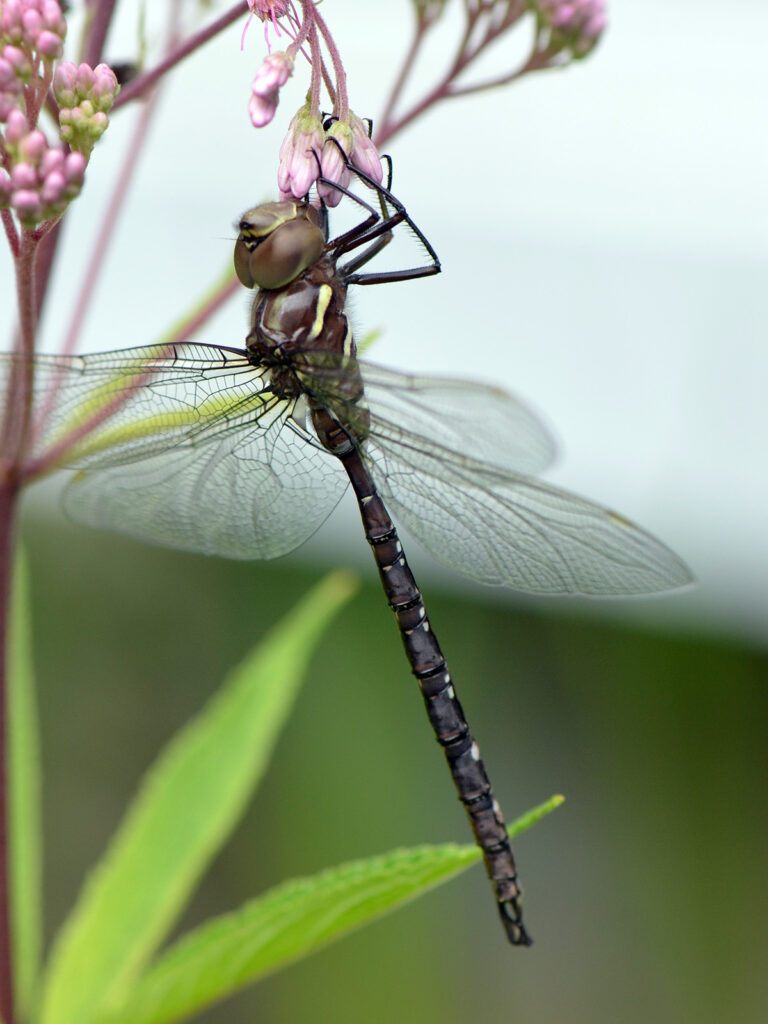
We’ve enjoyed watching dragonflies and damselflies (comprising the order Odonata) fly around our yard, as well as raising their young.
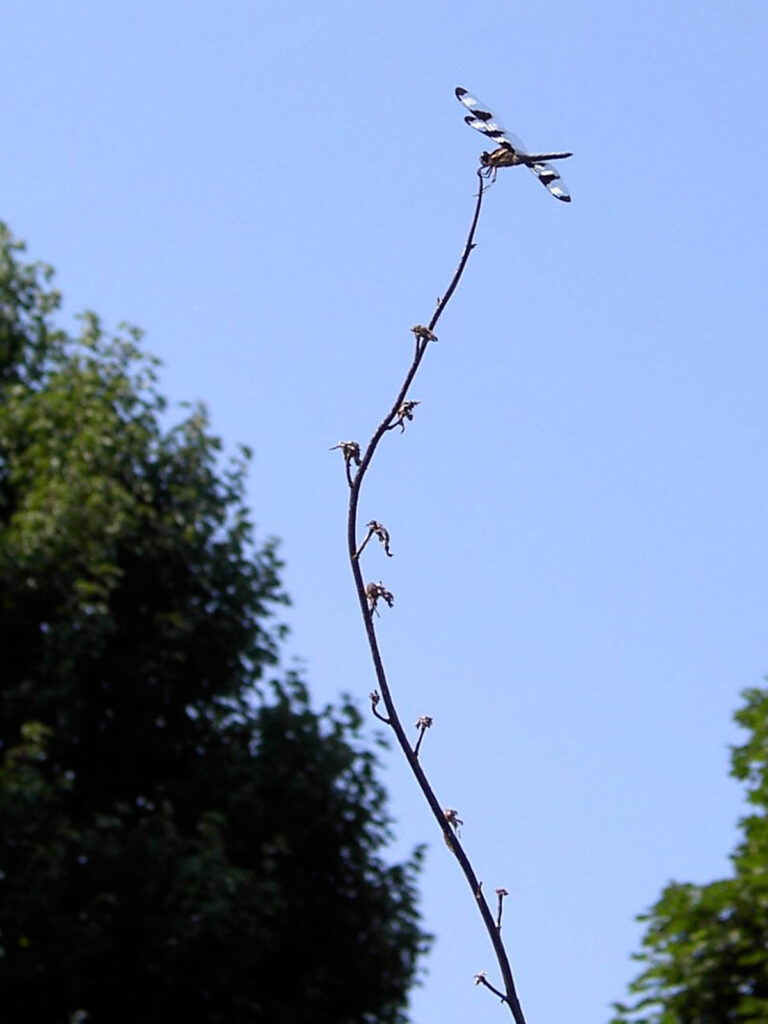
Dragonflies are very territorial, making them especially interesting to watch. This old plant stalk, left over from the previous summer, was the favorite place for this dragonfly to oversee his territory one year.
Whenever they spot a competitor, they dart out, protecting their space. They also spend some time patrolling our little ponds.
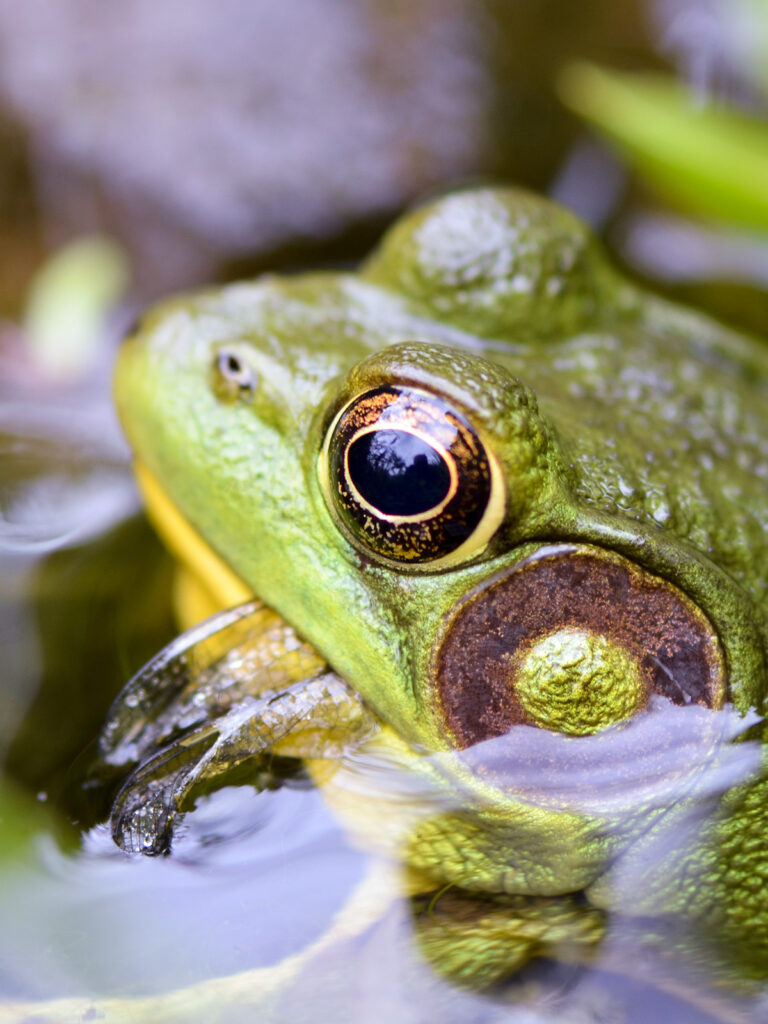
As insects, they’re fair game for other creatures, such as frogs and birds — if they can catch them. But they themselves are fierce and effective hunters. Both in their adult and nymph life stages, they eat a lot of insects and their larvae, which is probably why we don’t have mosquitoes in our yard even though we have two ponds. They don’t nickname them “mosquito hawks” for nothing!
Although they reproduce in the pond and the nymphs overwinter there, after they emerge, they don’t just stick around the pond. I’ve found quite a few around the yard.
Creating habitat for dragonflies and damselflies
To attract dragonflies and damselflies, experts recommend a pond about 20 feet in diameter and at least two feet deep. Unfortunately, neither our first pond (about 10 feet in diameter) nor our wildlife pond (about 12 feet by 7 feet) meet those requirements, and their maximum depths are less than two feet.
We created them with a series of “shelves,” however, so they do have varied depths and are shallow at the edges, which is recommended. (These shallow edges are also important for other wildlife.)
Though we didn’t plan for this, we’re fortunate that our ponds happen to meet some other requirements: being protected from wind and being in the midday sun.
And after a particularly harsh winter, our ever-multiplying group of 25¢ goldfish died. What at first seemed sad since we had enjoyed their colorful presence became a blessing. It turns out that they eat Odonata nymphs as well as frog and toad tadpoles. This shouldn’t have surprised us, but we were novices in the ways of the aquatic world.
And as a bonus, our “meadow” area is right next to the ponds so the dragonflies have an insect “grocery store” readily available.
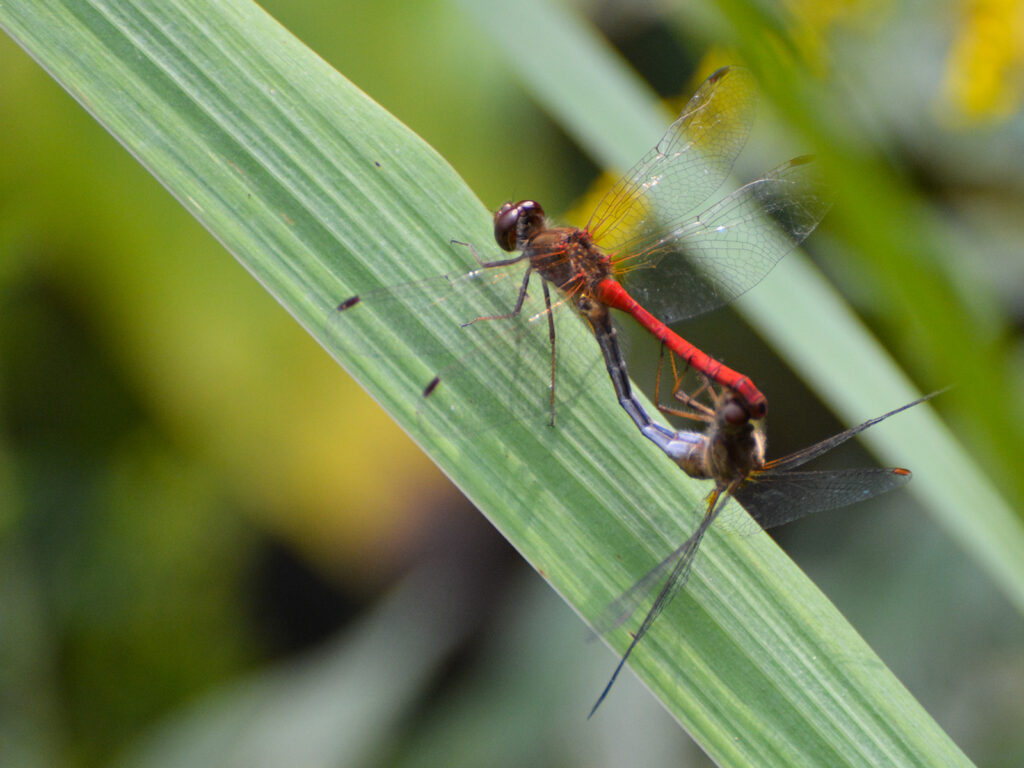
So even though they may not be ideal dragonfly ponds in terms of size, we’ve had a variety of dragonflies and damselflies frequenting our ponds and breeding here, such as these white-faced meadow hawk damselflies.
Had we known there was any possibility of having dragonflies in our suburban neighborhood, and had we known how much we enjoy them, we might have designed larger ponds!
Identifying our Odonata
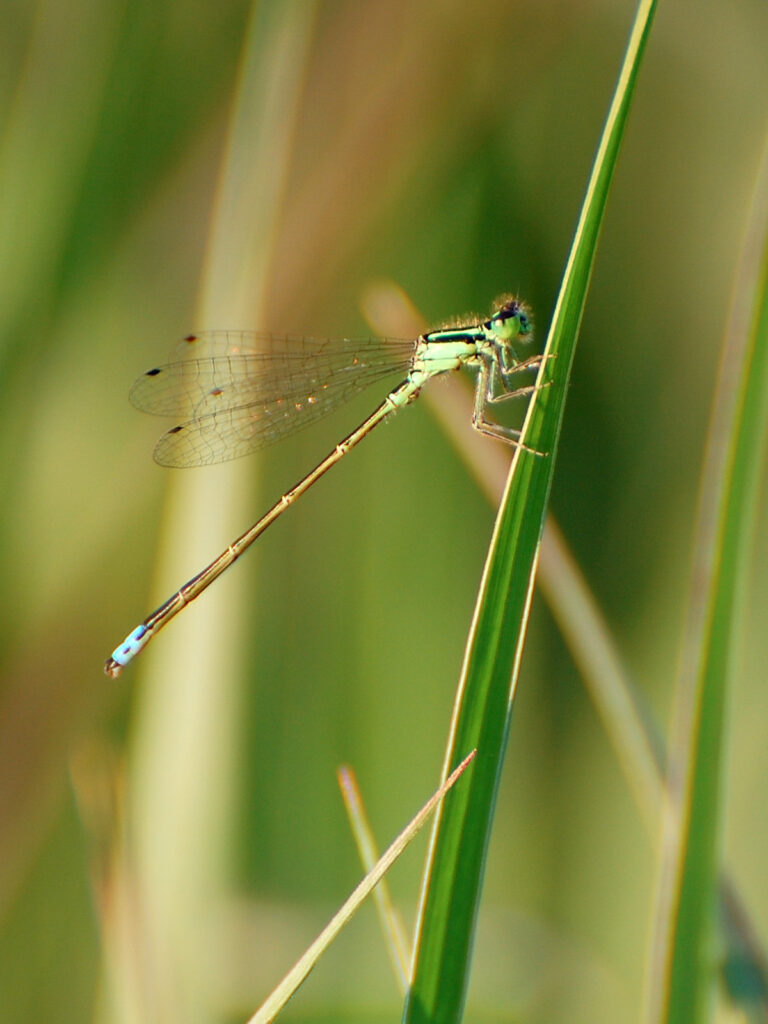
One of the challenges in identifying dragonflies is that the females and males look so different. It really doubles the effort to learn to identify them. The females often have transparent wings with fewer markings than their male counterparts.
One of the challenges in identifying dragonflies is that the females and males look so different. It really doubles the effort to learn to identify them. The females often have transparent wings with fewer markings than their male counterparts.
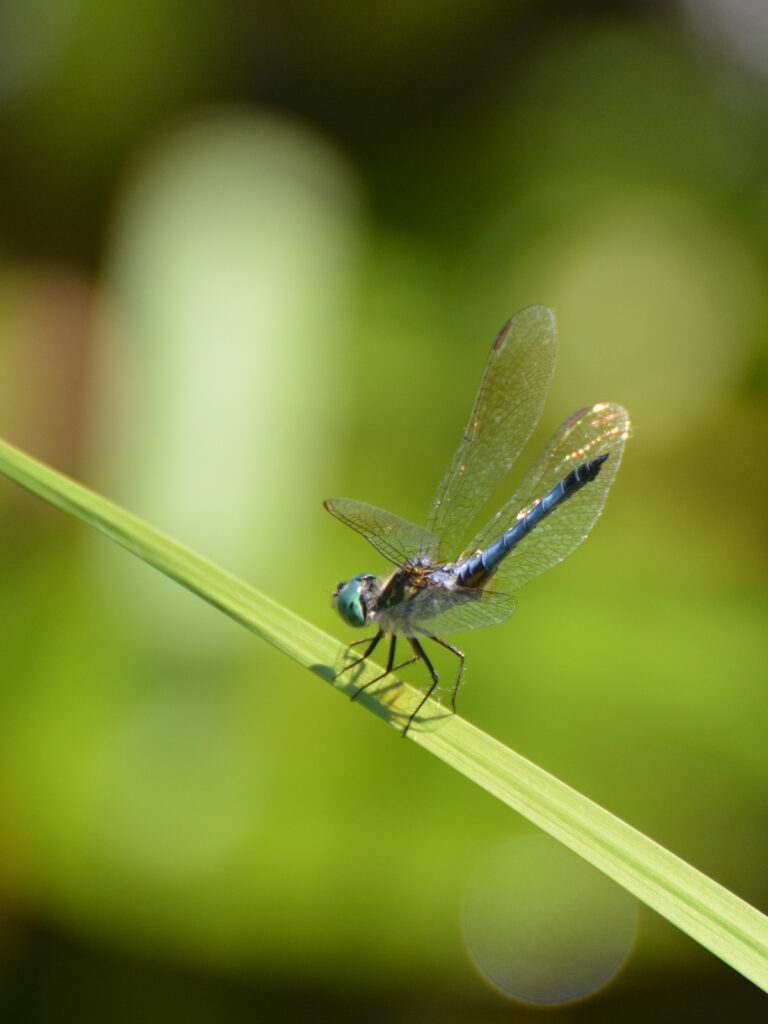
Since this dragonfly was blue, in “obelisking” posture, and in its geographic range, I guessed that this might be the Blue Dasher.
Since then I have discovered the wonders of BugGuide.net and Odonata Central for identification help.
At least for those we’ve been able to photograph and identify, the following pages show the dragonflies and damselflies we’ve seen in our yard:
Resources
- Stokes:
- Beginners Guide to Dragonflies book. It’s not adequate for advanced users, but it has served me well. It gives background about the life cycle of dragonflies, tells how to distinguish among various families, and has good photos for identification.
- The Xerces Society:
- Backyard Pond Guidelines for Creating and Managing Habitat for Dragonflies and Damselflies – a free PDF booklet – EXCELLENT!
- National Wildlife Federation:
- Ecosystem Gardening:
- Beyond Pesticides:
- Migratory Dragonfly Partnership:
- Dragonfly ID app
- Dragonfly Swarm Project: If you happen to see a dragonfly swarm, please report it!
- Biggs’ Wildlife Pond:
- Excellent website about a wildlife pond in California … that led to its owner writing a book on dragonflies! (AND it includes a photo of my wildlife pond!)
- NY Times:
- Nature’s Drone, Pretty and Deadly notes that dragonflies:
- catch 95% of their targeted prey,
- can focus on one object at a time,
- have separate sets of muscles for each of their four wings,
- can fly up to 30 mph, and
- have among the best eyes in the animal kingdom.
- Nature’s Drone, Pretty and Deadly notes that dragonflies:
Reflections
From a gardener’s perspective, Odonata are almost perfect insects. The rumor that dragonflies will sew our eyes shut while we sleep is highly suspicious and we gardeners need not fear such a fate. We’re far too busy to take a nap.
~ Eric Grissell, Insects and Gardens, p. 58
